I knew my Swedish immigrant great grand Uncle Erick Dalin was a veteran of WWI. What I didn’t fully appreciate until recently was that he volunteered to serve – at age 49!
It’s time to learn a little more about Erick’s military experience.
WWI RESEARCH
I remembered that I had located an “Application for Headstone or Marker”, which is often a good source of information. So I decided to start there and quickly noticed that he served with the 27th Engineers Corp. [This information is also referenced on his headstone.]

After a bit of searching on the Internet, I located an interesting book at the Internet Archive entitled History of the 27th Engineers, U.S.A., 1917-1919, published by the Association of the 27th Engineers in 1920. I searched for Erick’s name, and voila! There he was, listed on pg. 80 as one of the Privates in Company E.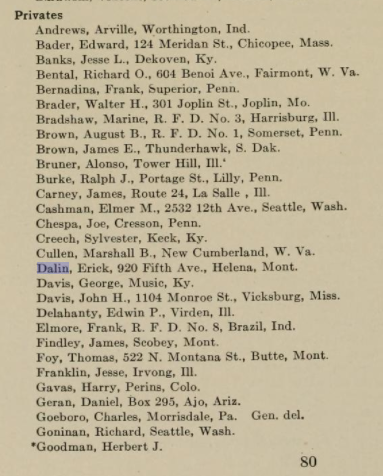
The book contains an interesting history of the Battalion, including an explanation of how the group came into existence.
HISTORY OF THE 27TH ENGINEERS, WWI
The 27th Regiment of Engineers was organized late in the war by order of the Department of War. The August 15, 1917, order specified that the Regiment consists of “certain special and technical engineer troops”, both voluntary and draft, “among which was a specified mining service, consisting of regimental headquarters and six companies.”
In an effort to recruit special engineer units, a telegraphic dispatch was sent to the Engineering and Mining Journal on October 31, 1917. The telegram stated that “an appeal for aid in securing volunteers for mining service in France” was being sent on that date in the form of a letter. A few interesting points from that letter include . . .
- The regiment was to be made entirely of “picked men” from various mining sections of the country.
- Work was to consist of preparation of underground shelters for fighting troops and placing of explosive mines.
- The troops would be trained to fight as well as to mine.
Ah Hah! It was all beginning to make sense. Erick and my great grandfather Andrew settled in Hassel, Montana – a small mining town. I even remember my Dad telling me that his grandfather Andrew “timbered the mines” in Hassel.
HEADED TO FRANCE
By the end of June 1918, the first battalion (companies A, B, and C) sailed for France. And the business of organizing the second battalion began in earnest. Placer, hard rock, gold, and coal miners came from everywhere. Alaska, California, Colorado, Arizona, Michigan, Kansas, Missouri, Pennsylvania – and Montana.
As the Batallion was under orders to prepare for embarkation as soon as the organization was complete a most strenuous course of instruction for both officers and men was inaugurated and carried out [at Camp Leach in Washington, D.C.] in spite of around 100° F. in the shade. This heavy drill rapidly eliminated the physically unfit and the three companies soon rounded into shape.
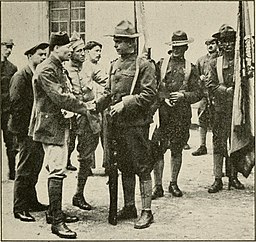
THE ARGONNE-MEUSE OFFENSIVE
By the time all companies were united and serving as a whole in October 1918, the Argonne-Meuse offensive was well underway and the work of the 27th Engineers quickly transitioned to that of bridge building.
. . . trench positions had been abandoned, or were being used for temporary shelter only; the war of movement was on, and mining warfare . . . was at an end. Thus it was that the 27th, which had been intended for mining work in underground operations, was thrown into other forms of engineering, finally to establish itself as the bridge building regiment of the First Army Engineers.
The activities of all the companies, including the company to which Erick was assigned, are detailed in the book.
COMPANY E (SECOND BATALLION)
Company E was relieved from duty on General Construction on October 27, 1918, and sent to open the highway “on which the First Army was largely dependent for all supplies . . .” between Montblainville and Apremont. “Air raids were of daily occurrence and many spectacular air battles were seen by the company.” In addition, German propaganda planes dropped small printed circulars in the area.
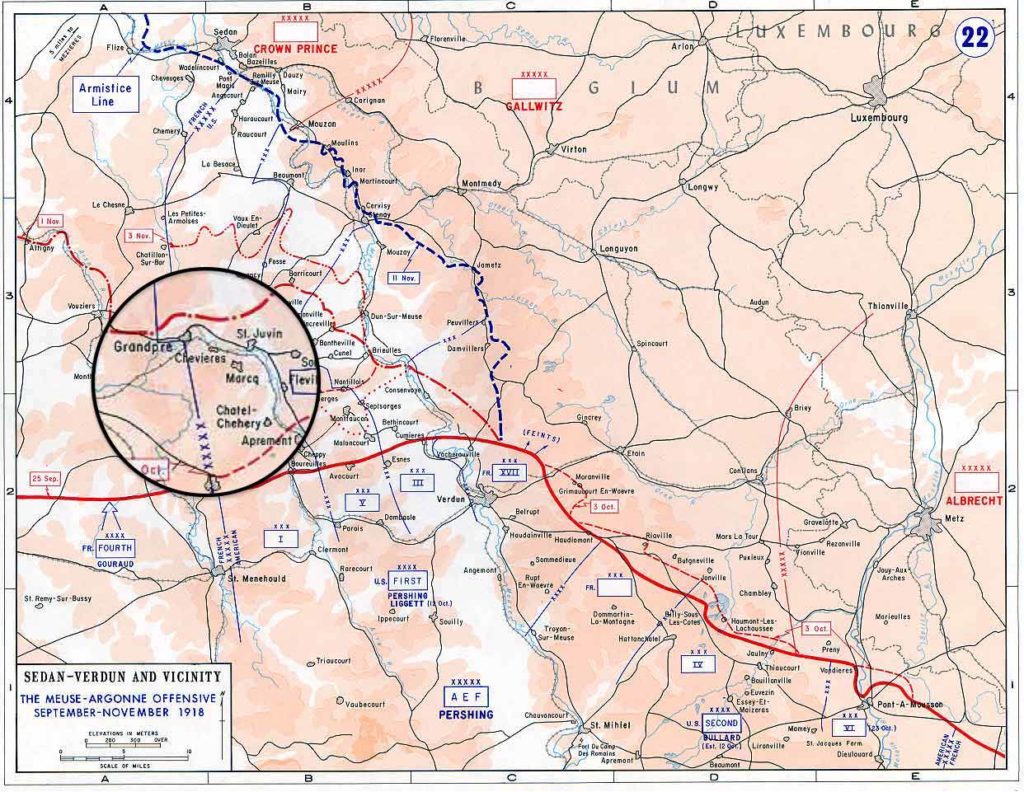
The Company was ordered to march north on November 8th. They arrived in the town of Grandpre the next day. Over the next few weeks, they completed work on bridges under construction by Company A and began construction on three new bridges. The largest bridge “required timber work of the highest order . . . and the entire bridge with the exception of the abutments was built in five days.”
During the same time period, Company E also built a five-span pile bridge and two-span crib bridge. They also performed a large amount of repair work on roads and bridges in the area.
And if that wasn’t enough, the Company also cleared out and repaired a number of wrecked buildings in the town. Having been shelled by both German and American forces, “not a building except the concrete dug-outs was left intact.”
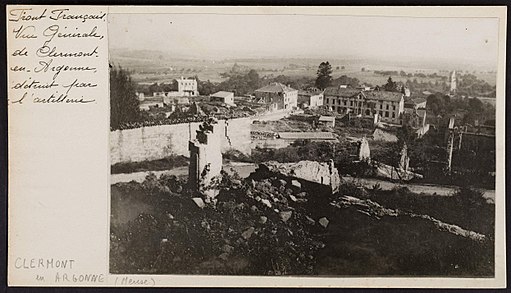
The Company gradually managed to set themselves up in fairly comfortable quarters. The area became “a stopping place for refugees and wanderers drifting back from German prison camps after the signing of the armistice, as this was the first American post for refugees traveling homeward via the Aisne and Aire valleys. Many pitiful wrecks were cared for and many strange stories listened to during these days.”
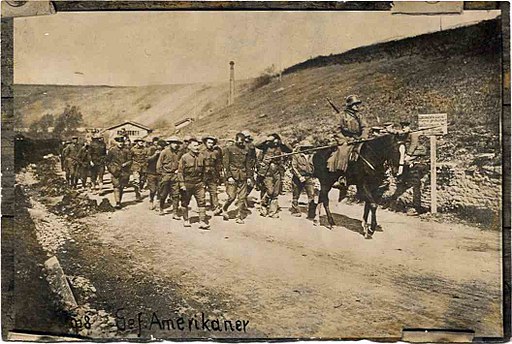
MANY THANKS TO THE INTERNET
I now suspect Erick had some powerful stories to tell about his military experience during WWI. Unfortunately, those stories were not passed down in the family. However, thanks to the Internet, I was able to learn incredible details of events in which Erick and the 27th Engineers played a pivotal role.
SOURCES
History of the 27th Engineers, U.S.A. 1917-1919 : Association of the 27th Engineers, 1920. 1–17, 48. Internet Archive. Web. 27 Jul. 2018.
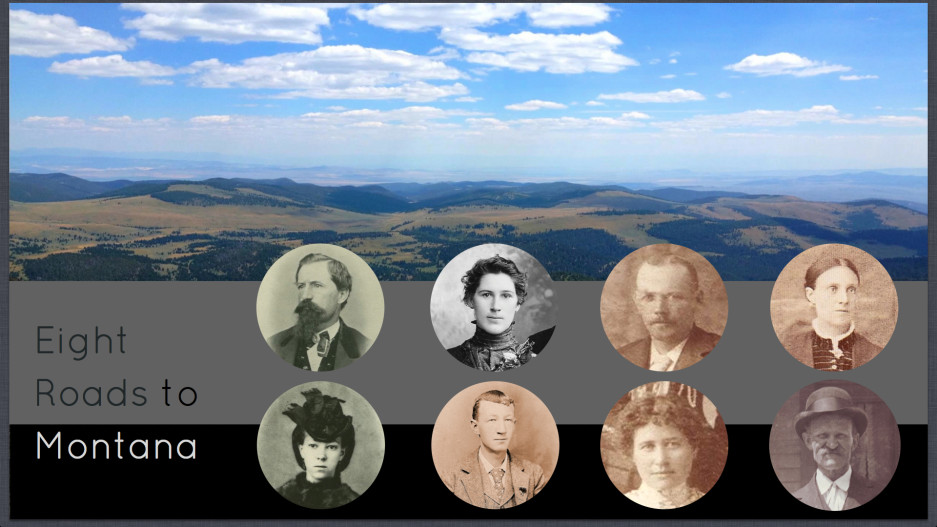
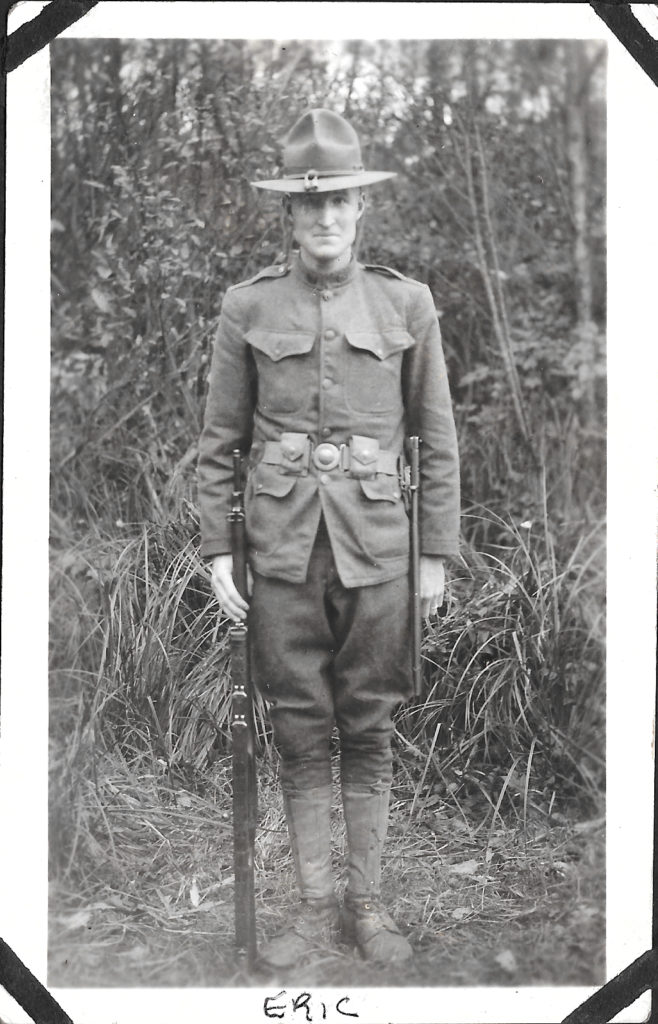

My grandfather Lt. James Owen Greenan was with Hq. Company with the 27th Engineers in France. I have the German war souvenirs he brought back. He went to Coblenz during the occupation to work on mines that had been flooded. He was billited with a French family post war and spoke French fluently.
Originally from Taunton Mass. A graduate of MIT as a mining engineer.
Hi Ruland, Thanks so much for sharing your grandfather’s story. How long was he billited with the French family? I’ll bet he had some amazing stories to tell!
I am originally from Grandpre in France, great to get some local history!
Good research, well done.
Thanks so much for your interest. I’m working on a follow-up blog post that you might find equally interesting! I hope to have it up in the next few days.
A facet of WWI history I was unaware of! I enjoyed reading it. The need for men with mining experience was particularly interesting.
Thanks for your comment, Liz. I also found the mining experience piece of this story very interesting. And I’m always amazed by what I find about my ancestors on the Internet!